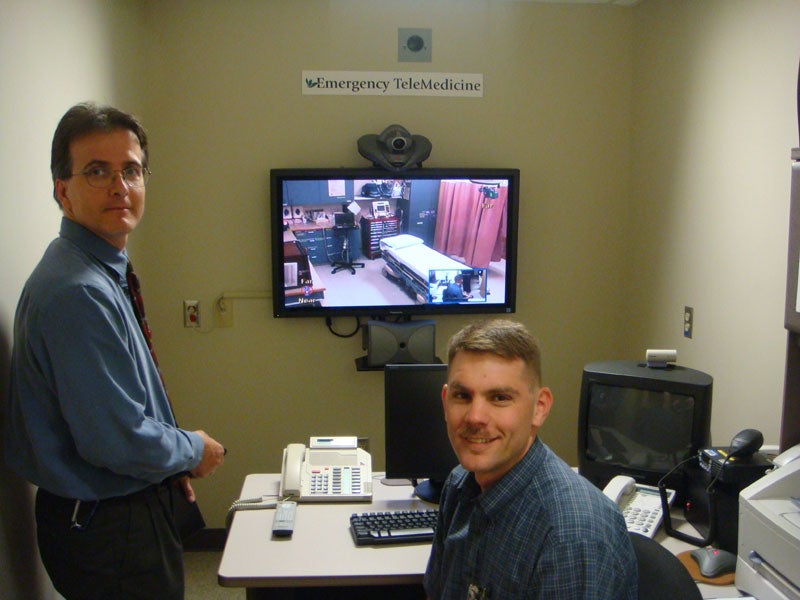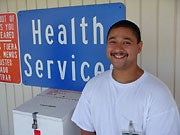Envision TelepharmacyDescription of the pharmacy.Envision Telepharmacy is a Texas-licensed pharmacy that provides electronic supervision of pharmacy technician (EST) services for facilities with fewer than 101 beds, remote order-entry (ROE) services, and Pharm-Q, a Web-based system for order scanning and imaging. Services are provided 365 days per year and 24 hours per day. Within the parameters of a given state board’s rules and regulations, services can be scheduled to remotely provide any number of coverage hours on an ongoing or temporary basis. ROE services focus on one task, while EST services involve performing tasks for full-service operations. Pharm-Q products support local electronic order-scanning, ROE, and EST services for facilities and pharmacists who wish to provide or receive remote pharmacy service.
Most of the pharmacists at Envision are married women age 30–50 years with at least one dependent living at home. Twenty percent belong to a minority race, and 40% live in rural areas. The majority have other hospital pharmacy jobs as well.
Groups of three to nine pharmacists provide ROE services, with the majority of pharmacists working fewer than 20 hours per week. In all small and rural facilities currently using ROE services, the hours of coverage occur when there is no onsite pharmacist, typically evening hours and weekends. Service coverage occurs six or seven days each week and ranges from 47 to 92 hours weekly.
EST services are provided by groups of up to four pharmacists. Hours covered are typically daytime and weekday evenings. Service coverage ranges from one to seven days weekly and from 4 to 58 hours per week. Most pharmacists who cover EST services work more than 40 hours per week.
Serviced hospitals range from very small rural facilities to large urban facilities, and the level of onsite technology in place at the facilities varies enormously. For example, the smallest facility using EST services has 4 beds and no automation and lacks a computerized order-entry system. In contrast, a >350-bed ROE facility is heavily automated, utilizes pharmacy robotics, and has a completely paperless medication-order-processing system. For the purposes of this article, discussion will be limited to small (fewer than 101 beds) and rural hospitals.
Small hospitals currently receiving Envision’s ROE services range from a bed size of 29 to 100 with 1–11 onsite pharmacists. Onsite pharmacy operation is provided 40–93 hours weekly during weekdays. Directors of pharmacy in small hospitals often perform some or all of the pharmacy staffing duties in their departments. When staff is short, it is usually pharmacy leadership that must fill in for staffing vacancies. They are generally faced with a comparable number of administrative tasks as their counter-parts in larger facilities and have less support staff to accomplish them. When they fulfill staffing duties, their administrative work waits.
EST services are used in facilities with 4–40 beds and where consultant pharmacists are onsite fewer than five days per week or in facilities with a full-time pharmacist onsite but that wish to extend their hours of operation into the evenings or weekends. The smallest hospital receiving EST services is staffed with a consultant pharmacist who is present one day weekly, while the hospital with the largest staff receiving EST services has 1.5 pharmacist FTEs. Onsite pharmacist-directed operation is provided 4–40 hours weekly. Full pharmacy operation (onsite plus remote) is provided 8–58 hours weekly.
Creative schedules. For Envision Telepharmacy, the schedule is created by a central scheduler. Technology is used to collaborate, coordinate, confirm, and view shift coverage. Envision’s scheduling philosophy includes the idea that pharmacies should be staffed in a manner that the workload during a shift enables pharmacists to take care of all medication-related issues in a timely manner and that the onsite pharmacist can return to work without any leftover tasks. Consequently, more staff may be scheduled during higher-volume hours. Coverage requested by a hospital in addition to its usual coverage and any open shifts are filled by the pharmacists on a first-come, first- served basis.
As long as the coverage needs of the facility are met, almost any scheduling arrangement preferred by individual pharmacists and/or the pharmacist group covering the facility is acceptable. Staffing involves a great variety of shift lengths and intervals. Shifts range from 2 to 10 hours. The shortest workweek is 2.5 hours for a single pharmacist, and the longest workweek is 63 hours for pharmacists who work schedules of seven days on and seven days off.
There is also considerable variation in terms of cross-training between pharmacist groups for individual pharmacists or for cross-coverage of multiple facilities. Pharmacists may choose to work for one facility on some of their shifts and for another facility on other shifts or simply always work for a single facility.
Seventy-four percent of Envision pharmacists rated their satisfaction with their work as a 5 on a scale of 1 to 5, where 5 represents a rating of very satisfied. To date, no pharmacists have initiated termination of their working relationship with the program. Some pharmacists work from the pharmacy (Envision Telepharmacy), while others work remotely using the Envision website as a virtual site from which to provide services. Experienced hospital pharmacists who wish to reduce their time commitments in their careers find remote work a suitable practice. In addition, pharmacists who frequently relocate can continue to keep the same work schedule and work site.
Workload reports and errors are tracked for Envision pharmacists both during the start-up phase of services and on an ongoing basis. Error rates during the three-month start-up period range from 0.12% to 0.5%, and ongoing error rates range from 0.02% to 0.06%. For facilities willing to share their internal error rates and turnaround time reports, the Envision Telepharmacy’s error rate and turnaround time are the same as or, more frequently, below those of the onsite pharmacists. Pharmacists periodically receive reports on their workload volumes and turnaround times along with comparative data for the facility. The high-tech workplace gives pharmacists with interests in information technology an opportunity to work with cutting-edge technology. Ease of access through a Web-based electronic order-management system allows for communication with the nursing or pharmacy technician on
duty at the serviced facility as well as the returning onsite pharmacy department staff. Technology offers pharmacists an opportunity to experience work in a specialty practice area to which they might not otherwise have geographic access.
Scheduling philosophy varies regarding onsite and remote staffing among the serviced hospitals. Some facilities use remote services due to lack of availability of a pharmacist in their area, some regard remote staffing as a way to provide partial or full services during lower-volume hours at a reduced cost, and some wish to extend hours of service by using remote pharmacists. Hospitals may utilize remote services to supplement their onsite staffing in order to free up time for the onsite pharmacists to provide clinical or administrative duties, or simply to take the order-entry burden off of the onsite staff during high-volume hours or periods of pharmacist shortages. Even if the pharmacy leader does not routinely staff the pharmacy, remote pharmacists can be used to staff a pharmacy department during the temporary pharmacist shortage that may occur during holidays, vacations, continuing-education attendance, sick time, and family and medical leave.
Rural hospitals use remote services to comply with regulatory or accreditation agencies, as well as to increase patient safety with the use of experienced hospital pharmacists and increased prospective review of medication-related processes. To more successfully recruit and retain onsite pharmacists in their pharmacy departments, rural hospitals use remote services with the goals of eliminating or greatly reducing the volume of after-hours calls to the hospital’s on-call pharmacist and allowing the onsite pharmacist to return to the department with work caught up and documentation intact on activities occurring since his or her departure.
The most common scheduling philosophy adopted by facilities desiring EST services is that patient safety is enhanced when the medication-related processes of the hospital are prospectively reviewed and controlled by a remote pharmacist rather than by nursing or unsupervised pharmacy technicians coupled with retrospective review by an onsite pharmacist. The philosophy often encompasses the belief that consultant pharmacist time spent on retrospective review of supportive personnel can be eliminated or greatly reduced and that this time can be spent on departmental management and administration, regulatory and quality processes, staff education, and cost-saving clinical activities. The cost of EST services is reliably less than the cost of an onsite pharmacist. For facilities with a full-time pharmacist, this staffing model can be most cost-effective during evening or weekend hours or to fill needs during a short shift. For a facility with less than a full-time on-site pharmacist primarily providing retrospective review of limited pharmacy activities (order review, medication removal from the pharmacy by non-pharmacists), the service can affordably shift the activities toward prospective review and full pharmacy services.
Challenges. Due to the nature of remote work and the hours the pharmacists typically provide service, administrative staff are lacking in frequent face-to-face interactions with pharmacists. As well, pharmacists who work together may not have even met face-to-face. For administrative staff, excellent telephone and electronic communication skills are essential to successful operation of the service and in building a relationship with the pharmacists. Communication systems are in place for the pharmacists both to communicate facility-specific information and to collaborate with one another while on duty. Camaraderie and team building are evidenced through use of those systems by the pharmacists and the rapid filling of open shifts.
Scheduling of the pharmacist staff is complex. The large variation in preferences for shift lengths and the number of pharmacists and facilities, along with numerous licensure and split-shift combinations, present an ongoing challenge for the central scheduler. Changes to schedules or requests for additional hours with short notice are difficult to fill. Electronic communication systems are in place for schedule posting, viewing, confirmation, and review.
Not all pharmacists are well suited to provide remote services. Pharmacists who are self-motivated, like independent work, and have the ability to learn about and become comfortable with the capabilities and limitations afforded by computer technology can thrive in this practice setting.
EST service is not, nor is it designed to be, as efficient as an onsite pharmacist. An adequate technician staff, as well as on-site pharmacist and administrative support, is essential to the success of this practice model. Attempts to utilize this service in a busy environment are self-limiting, since facilities whose medication volume warrants a full-time pharmacist over long periods of time simply cannot be served adequately by this practice model. Although satisfaction surveys have not been distributed, feedback received from nursing is consistently positive or neutral, with the following exception: in facilities with rapid onsite dispensing times (<15 minutes) for medications that must be supplied from the pharmacy, the relative wait time for medication to be delivered to the floor is increased. For example, in a small facility, a delivery time of 30 minutes for a new medication ordered for a patient before discharge may seem unacceptable to a nurse, even though the pharmacy may be feeling the pressures of being in the first hour of operation for the day and of the morning medication pass due within the hour.
DiscussionThese case studies present several examples of how unique and alternative work schedules can be integrated into the day-to-day operations of health-system pharmacies. The most recent ASHP staffing survey found pharmacist and technician turnover rates of 9% and 12.4%, respectively, and 48% of respondents were considering nontraditional staffing solutions in an effort to recruit and retain staff.7 While no two hospitals or pharmacy practice environments are exactly the same, it is up to each pharmacy practice manager through collaboration with the staff to come up with solutions that can meet the needs of the changing pharmacy work force.
ConclusionCompressed workweeks, job-sharing, and team scheduling were the most common types of alternative work schedules implemented at three different institutions.
References1. ASHP Task Force on Pharmacy’s Changing Demographics. Report of the Task Force on Pharmacy’s Changing Demographics. Am J Health-Syst Pharm. 2007; 64:1311-9.
2. Mott DA, Doucette WR, Gaither CA et al. Pharmacist participation in the workforce: 1990, 2000, and 2004. J Am Pharm Assoc. 2006; 46:322-30.
3. American Society of Health-System Pharmacists. ASHP long-range vision for the pharmacy work force in hospitals and health systems: ensuring the best use of medicines in hospitals and health systems. Am J Health-Syst Pharm. 2007; 64:1320- 30.
4. Pedersen CA, Schneider PJ, Scheckelhoff DJ. ASHP national survey of pharmacy practice in hospital settings: dispensing and administration—2005. Am J HealthSyst Pharm. 2006; 63:327-45.
5. Deal JJ. Retiring the generation gap: how employees young and old can find common ground. San Francisco: Josey-Bass; 2007:144-71.
6. Proctor C. Flex appeal: it’s all in the planning . www.ama-assn.org/ amednews/2007/08/13/bisa0813.htm (accessed 2007 Oct 13).
7. Schecklehoff DJ, Bush C. 2006 ASHP pharmacy staffing survey results. www.ashp. org/s_ashp/docs/files/StaffSurvey2006.pdf (accessed 2008 Aug 20). Source








